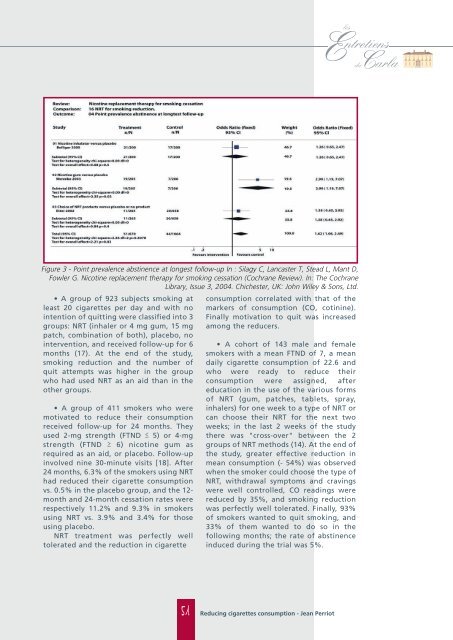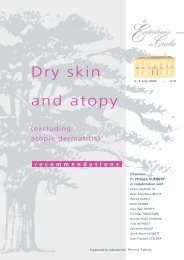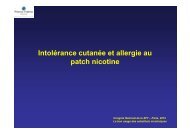Nicotine replacement therapy … - Carlos A ... - Entretiens du Carla
Nicotine replacement therapy … - Carlos A ... - Entretiens du Carla
Nicotine replacement therapy … - Carlos A ... - Entretiens du Carla
Create successful ePaper yourself
Turn your PDF publications into a flip-book with our unique Google optimized e-Paper software.
Figure 3 - Point prevalence abstinence at longest follow-up In : Silagy C, Lancaster T, Stead L, Mant D,<br />
Fowler G. <strong>Nicotine</strong> <strong>replacement</strong> <strong>therapy</strong> for smoking cessation (Cochrane Review). In: The Cochrane<br />
Library, Issue 3, 2004. Chichester, UK: John Wiley & Sons, Ltd.<br />
• A group of 923 subjects smoking at<br />
least 20 cigarettes per day and with no<br />
intention of quitting were classified into 3<br />
groups: NRT (inhaler or 4 mg gum, 15 mg<br />
patch, combination of both), placebo, no<br />
intervention, and received follow-up for 6<br />
months (17). At the end of the study,<br />
smoking re<strong>du</strong>ction and the number of<br />
quit attempts was higher in the group<br />
who had used NRT as an aid than in the<br />
other groups.<br />
• A group of 411 smokers who were<br />
motivated to re<strong>du</strong>ce their consumption<br />
received follow-up for 24 months. They<br />
used 2-mg strength (FTND ≤ 5) or 4-mg<br />
strength (FTND ≥ 6) nicotine gum as<br />
required as an aid, or placebo. Follow-up<br />
involved nine 30-minute visits [18]. After<br />
24 months, 6.3% of the smokers using NRT<br />
had re<strong>du</strong>ced their cigarette consumption<br />
vs. 0.5% in the placebo group, and the 12month<br />
and 24-month cessation rates were<br />
respectively 11.2% and 9.3% in smokers<br />
using NRT vs. 3.9% and 3.4% for those<br />
using placebo.<br />
NRT treatment was perfectly well<br />
tolerated and the re<strong>du</strong>ction in cigarette<br />
51<br />
consumption correlated with that of the<br />
markers of consumption (CO, cotinine).<br />
Finally motivation to quit was increased<br />
among the re<strong>du</strong>cers.<br />
• A cohort of 143 male and female<br />
smokers with a mean FTND of 7, a mean<br />
daily cigarette consumption of 22.6 and<br />
who were ready to re<strong>du</strong>ce their<br />
consumption were assigned, after<br />
e<strong>du</strong>cation in the use of the various forms<br />
of NRT (gum, patches, tablets, spray,<br />
inhalers) for one week to a type of NRT or<br />
can choose their NRT for the next two<br />
weeks; in the last 2 weeks of the study<br />
there was "cross-over" between the 2<br />
groups of NRT methods (14). At the end of<br />
the study, greater effective re<strong>du</strong>ction in<br />
mean consumption (- 54%) was observed<br />
when the smoker could choose the type of<br />
NRT, withdrawal symptoms and cravings<br />
were well controlled, CO readings were<br />
re<strong>du</strong>ced by 35%, and smoking re<strong>du</strong>ction<br />
was perfectly well tolerated. Finally, 93%<br />
of smokers wanted to quit smoking, and<br />
33% of them wanted to do so in the<br />
following months; the rate of abstinence<br />
in<strong>du</strong>ced <strong>du</strong>ring the trial was 5%.<br />
Re<strong>du</strong>cing cigarettes consumption - Jean Perriot






